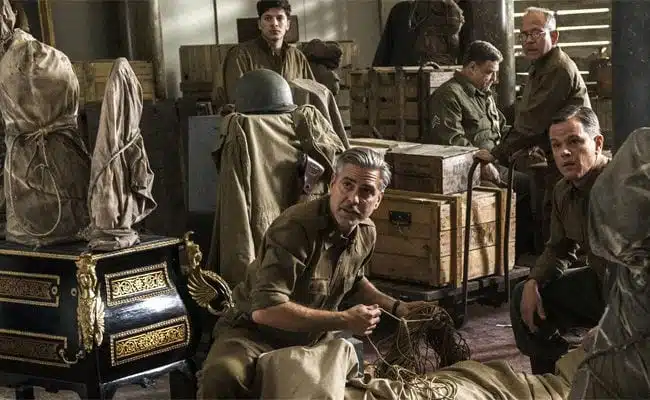
If only John Sturges had been around to make this movie. In 1950s or ’60s Hollywood, the story of a thrown-together gang of art experts who bomb around Western Europe trying to save precious artworks from being destroyed in the fighting would have been stupendous ensemble-bait. The idea is classic men-on-a-mission stuff, with star turns available for fictional roles like the cool and seductive female French Resistance fighter, Philistine SS officer who grabs all the oil paintings he can but wouldn’t know a Rembrandt from his elbow, and the newly drafted Ivy League academic who gets his first taste of combat. It would have chucked all but a few scraps of historical truth for blockbuster expediency, but the results could still have been superb; The Great Escape didn’t suffer for being in large part “based on a true story” fantasy. Think The Guns of Navarone with a more pointed subtext.
Instead of romping adventure or on-the-edge drama, though, what we get in George Clooney’s sagging, impressed-with-itself The Monuments Men is none of the above. Based in part on Robert Edsel’s book, the film dramatically but understandably pares down the actual art recovery team’s scale from hundreds of people over many years to a small band of guys following the final Allied advance across Europe after D-Day. Instead of the real-life group’s continent-wide remit that covered untold thousands of plundered works, the film has them focus on recovering a small number of recognizable pieces (the 15th century Ghent Altarpiece, Michelangelo’s Madonna and Child). It even throws in a chaste romance with a bespectacled Parisian beauty for one of them.

Matt Damon and George Clooney in The Monuments Men
Less understandably, the film assembles a dream assemble and then abandons them without a story to work from. Clooney’s lack of control over his material is evident from the beginning. Playing team leader Frank Stokes, Clooney gets his presidential assignment (a bungled, laughable scene with one of the more comical FDR impressions seen on film since Annie) and starts getting the band together. Chicago architect Richard Campbell (Bill Murray), art restorer James Granger (Matt Damon), sculptor Walter Garfield (John Goodman), and the just generally artsy Preston Savitz (Bob Balaban). (Later on, Hugh Bonneville and Jean Dujardin join the gang for some Continental color.) This should be basic stuff, a few character-establishing moments and team-building quips, plus the easy comedy of watching the academics struggle through basic training before their mission.
But Clooney muffs almost everything from the start. The script (which he wrote with his producing partner Grant Heslov) is a patched-together thing that can’t even give Murray and Goodman, two of America’s living comic geniuses, anything to get a laugh out of. More damaging to the film’s momentum is how it splits the team up even before they get to Europe, sending Granger off to Paris to find out what art expert Claire Simone (a steely hard-working Cate Blanchett, wringing a sliver of greatness out of an otherwise embarrassing flirtatious dinner scene) knows about where the retreating Nazis have taken their stolen art. Meanwhile, the main body of the squad is running around the Western Front, with little equipment and no authority (quite a lot like the real Monuments Men), trying to save what they can before Hitler’s apocalyptic order to destroy it all is carried out.
Clooney’s directing aims as broadly as possible, but he can’t even get the easy things right. The film continually papers over the plot holes with puffed-up narrated speeches from Clooney and an unusually soapy score by Alexandre Desplat. It doesn’t help things that Clooney puts himself front and center. Stokes is the heroic, handsome academic who’s in charge not just of speechifying about the important of culture but also giving what for to the captured Nazi he faces down at the end. Clooney’s earlier directorial efforts like The Ides of March and Good Night and Good Luck were certainly not spectacular, but they were modest and competent works where he let other performers shine.
What those unsurprising works also share with The Monuments Men is a basic lack of imagination or deeper understanding of its story. This film keeps talking about how critical art is to society, but it never shows us. You would think that with all these rarefied cultural experts together, they would indulge in shop talk and gossip. But aside from a couple lines about the centrality of the Ghent Altarpiece to the history of Catholic art, and a flubbed gag where somebody doesn’t recognize a Vermeer, these Monuments Men appear to know as little about art as the average audience member.
There are few things more consequential than a culture’s artistic legacy. There are few things more bungled than this pompous and tiresome film about the crucial campaign to save that legacy.


